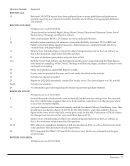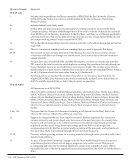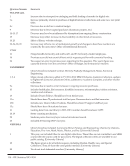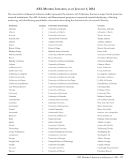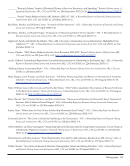66 · ARL Statistics 2013–2014
Question 3. Basis of Volume Count. A physical count is a piece count a bibliographic count is a catalog record
count.
Question 4. E-books. Report the number of electronic books held. Include electronic theses and dissertations.
This number is a subset of Volumes Held reported in Q2.
EXPENDITURES
Questions 6–12. Expenditures. Report all expenditures of funds that come to the library from the regular
institutional budget, and from sources such as research grants, special projects, gifts and endowments, and
fees for service. (For Salaries and wages include non-library funds see specific instructions below). Do not
report encumbrances of funds that have not yet been expended. Canadian libraries should report expenditures
in Canadian dollars. (For your information, if interested in determining figures in U.S. dollars, divide
Canadian dollar amounts by 1.0706, the average monthly noon exchange rate published in the Bank of Canada
Review for the period July 2013–June 2014). Please round figures to the nearest dollar.
Report figures for the following categories of expenditures:
Question 7. Total Library Materials Expenditures.
Question 7a. One time library materials expenditures. Report expenditures for all library materials that are
non-subscription, one-time, or monographic in nature include expenditures for software and machine-readable
materials considered part of the collections. Examples include periodical backfiles, literature collections, one
-time costs for JSTOR membership, etc.
Question 7b. Ongoing library materials expenditures. Report subscription expenditures (or those which are
expected to be ongoing commitments) for serial and other publications include online searches of remote
databases such as OCLC FirstSearch®, DIALOG®, Lexis-Nexis®, etc. Examples include paid subscriptions for
print and electronic journals and indexes/abstracts available via the Internet, CD-ROM serials, and annual access
fees for resources purchased on a “one-time” basis, such as literature collections, JSTOR membership, etc.
Question 7c. Collection support. Include miscellaneous expenditures as well as document delivery/
interlibrary loan. Include materials funds expenditures not included in questions (7a)–(7b), e.g., expenditures for
bibliographic utilities, literature searching, security devices, memberships for the purposes of publications, etc.
Please list categories, with amounts, in a footnote. Note: If your library does not use materials funds for non-
materials expenditures—i.e., if those expenditures are included in “Other Operating Expenditures”— report
0. Include all Contract Binding expenditures—that is only contract expenditures for binding done outside
the library. If all binding is done in-house, state this fact and give in-house expenditures in a footnote do not
include personnel expenditures in this question. Some computer hardware and software expenditures may be
reported here if they are expended from collection funds.
Question 8. Salaries and wages. Exclude fringe benefits. If professional, support staff and student salaries
cannot be separated, check the Manual Override box and enter the total.
Question 8c. Salaries and wages: Student Assistants. Report 100% of student wages regardless of budgetary
source of funds. Include federal and local funds for work study students.
Question 3. Basis of Volume Count. A physical count is a piece count a bibliographic count is a catalog record
count.
Question 4. E-books. Report the number of electronic books held. Include electronic theses and dissertations.
This number is a subset of Volumes Held reported in Q2.
EXPENDITURES
Questions 6–12. Expenditures. Report all expenditures of funds that come to the library from the regular
institutional budget, and from sources such as research grants, special projects, gifts and endowments, and
fees for service. (For Salaries and wages include non-library funds see specific instructions below). Do not
report encumbrances of funds that have not yet been expended. Canadian libraries should report expenditures
in Canadian dollars. (For your information, if interested in determining figures in U.S. dollars, divide
Canadian dollar amounts by 1.0706, the average monthly noon exchange rate published in the Bank of Canada
Review for the period July 2013–June 2014). Please round figures to the nearest dollar.
Report figures for the following categories of expenditures:
Question 7. Total Library Materials Expenditures.
Question 7a. One time library materials expenditures. Report expenditures for all library materials that are
non-subscription, one-time, or monographic in nature include expenditures for software and machine-readable
materials considered part of the collections. Examples include periodical backfiles, literature collections, one
-time costs for JSTOR membership, etc.
Question 7b. Ongoing library materials expenditures. Report subscription expenditures (or those which are
expected to be ongoing commitments) for serial and other publications include online searches of remote
databases such as OCLC FirstSearch®, DIALOG®, Lexis-Nexis®, etc. Examples include paid subscriptions for
print and electronic journals and indexes/abstracts available via the Internet, CD-ROM serials, and annual access
fees for resources purchased on a “one-time” basis, such as literature collections, JSTOR membership, etc.
Question 7c. Collection support. Include miscellaneous expenditures as well as document delivery/
interlibrary loan. Include materials funds expenditures not included in questions (7a)–(7b), e.g., expenditures for
bibliographic utilities, literature searching, security devices, memberships for the purposes of publications, etc.
Please list categories, with amounts, in a footnote. Note: If your library does not use materials funds for non-
materials expenditures—i.e., if those expenditures are included in “Other Operating Expenditures”— report
0. Include all Contract Binding expenditures—that is only contract expenditures for binding done outside
the library. If all binding is done in-house, state this fact and give in-house expenditures in a footnote do not
include personnel expenditures in this question. Some computer hardware and software expenditures may be
reported here if they are expended from collection funds.
Question 8. Salaries and wages. Exclude fringe benefits. If professional, support staff and student salaries
cannot be separated, check the Manual Override box and enter the total.
Question 8c. Salaries and wages: Student Assistants. Report 100% of student wages regardless of budgetary
source of funds. Include federal and local funds for work study students.













































































